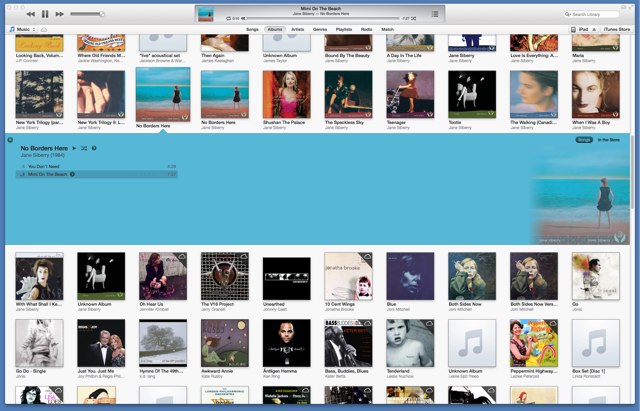
A 300 x 300 pixel image is actually over twice the size of a 200 x 200 image, and will consequently lead to approximately double file sizes. The Current Standard JPEG images of these dimensions will vary in file size (dependant on the compression ratio used and image complexity) from around 10kB to 80kB or so. The iPod touch screen is 480 x 320 pixels, more than sufficient to display images of 200 x 200 pixels. The resolution of the iPod nano and iPod classic screens is 320 x 240 pixels. The picture to the right is sized at 200 x 200 pixels by way of example and is 35kB in file size. iTunes currently displays album art as 200 x 200 pixel images.
#Itunes larger album art view how to#
How to add Cover artwork to an MP3 Windows Media Player embeds album artwork as 200 x 200 pixel images, although will display larger images if they are embedded in the playing file as a larger size. If on the other hand you add an 80kB album image to every single track in your MP3 collection, let’s say of 1,000 songs, then you’ll need any additional 80MB of storage, which could otherwise hold a further 20 songs or so (another 2 albums). For example, adding an 80kB JPEG image to a single 8MB podcast won’t have a significant effect it’s only a 1% increase in file size. However, this does need to be taken in context. Unfortunately, any additional information that you add to an MP3 file will increase its file size and this is of particular importance when adding images due to their potential size, even with compressed images such as JPEGs. The ID3 standard is very flexible with regards to the type and number of images that can be embedded in a MP3 single file.

Practically speaking JPEG images have been adopted as the de facto standard in this respect. While the ID3v2 tag standard allows any type of image to be embedded in an MP3 file, it does advise that either PNG or JPEG formats should be used when interoperability with playback devices is required. If you’re not familiar with ID3 tags, you may find my previous article on What are ID3 tags in MP3 files? helpful. ID3 tags allow you to store additional information within your MP3 files such as the track title, artist name and even album art. To include such extra information in an MP3 track, tag data is usually added to the beginning or end of the audio file in ID3 format. So, before you start cutting and pasting huge graphics and adding them into your collection of MP3 tracks, what do you need to consider to avert potential disaster?Ī standard MP3 file only contains audio data, with no additional information about the artist or type of audio contained within it. However, it wasn’t until version 2 of the protocol became available that MP3 files could actually contain embedded album art. While MP3 files were not originally intended to store additional metadata within them, the release of the ID3 tag protocol in 1996 suddenly made this a possibility.

However, before you start filling up all of your MP3 files with works of art, there are a few things that you should stop to consider first. It’s not much to ask to be able to choose an image for artists in this list instead of seeing a long column of microphones.Album art can be embedded into MP3 files fairly easily using ID3 tags. Sure, you can spot an artist’s name in the list, but the visuals made it even easier. While it wasn’t ideal before, since you couldn’t choose which album was used to illustrate an artist, the current display makes Artists view difficult to navigate. But artist lists seem to have been forgotten in this redesign. iTunes 12.5 has simplified many of the app’s interface elements, with larger text and much bigger album artwork. ITunes and the iOS Music app should make choosing and playing music easy. The photos don’t give me any idea who they are. Here are nine bands in my iTunes library. Here’s a shot of a number of group photos, with the names blurred there’s no way you’d be able to know who’s in these photos. Take a photo of a band and shrink it to a small circle, and I defy you to tell who it is. When there are artist photos, they’re often no help in identifying who they represent. Only a handful of artist photos display in iTunes 12.5.


If anything, I’d expect Apple Music tracks to show more artist photos, but on my MacBook, where I have only music from Apple Music, the number of artist photos is about the same as on the large iTunes library on my iMac, where the majority of music is ripped from CDs. These artist photos all come from Apple’s database, which is used for Apple Music and the iTunes Store. And it’s not a question of whether the music is purchased or ripped, or whether it is locally stored or comes from Apple Music. In iTunes 12.5 and the iOS 10 Music app, I see artist photos for perhaps 10 percent of my music.


 0 kommentar(er)
0 kommentar(er)
